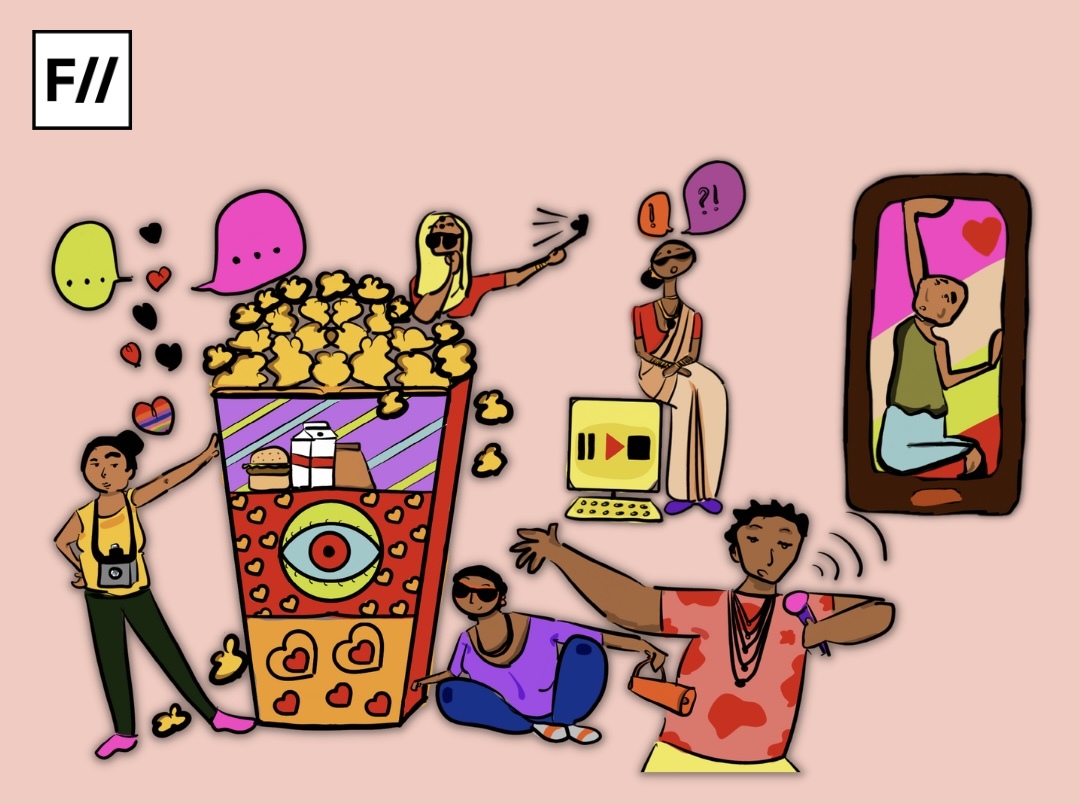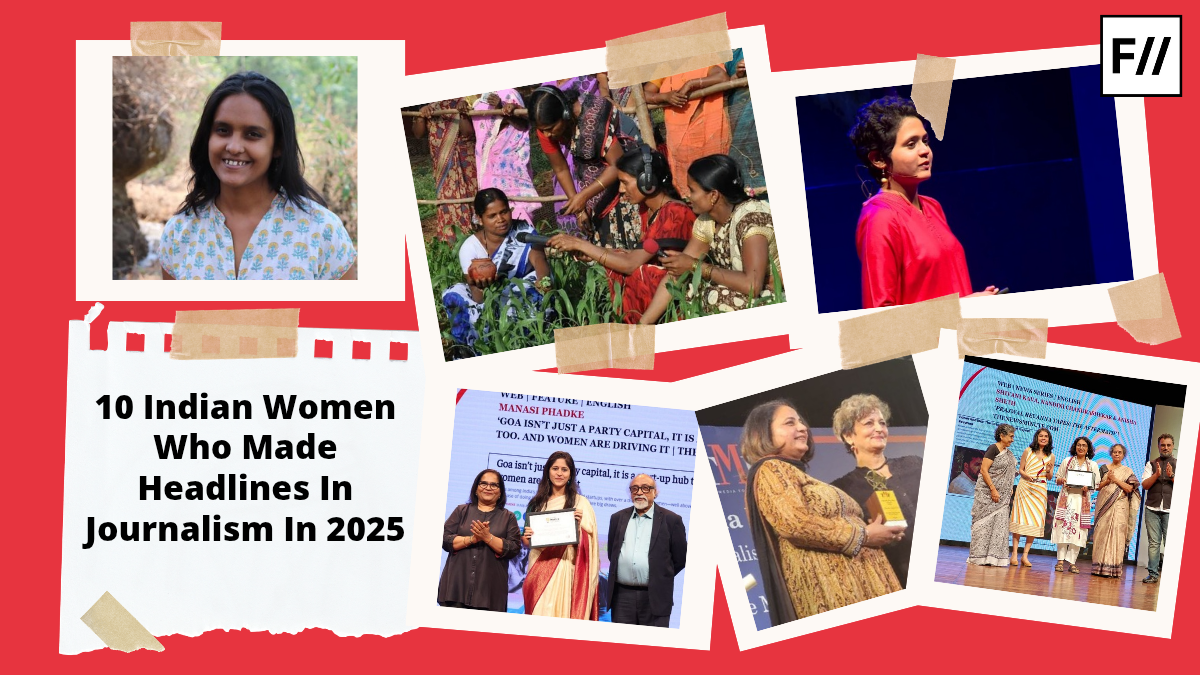“What begins online doesn’t stay online. Digital abuse spills into real life, spreading fear, silencing voices, and—in the worst cases—leading to physical violence and femicide.”
– Sima Bahous, Executive Director, UN Women
As entrepreneurial ventures in India get progressively digitalised, this stands as not just a warning but the lived reality of thousands of women and queer business owners who operate online. Most home-based, small-scale businesses today run on visibility through Instagram reels, handmade product videos, thrift drops, skincare tutorials and constant connection. The scope of this online visibility gets skewed in an AI-driven digital economy. Recommendation systems decide who gets to be seen. The aesthetics, tone and identity of emerging brands are relentlessly filtered by algorithms. Generative tools can turn a single photo into a deepfake in minutes. The same digital resources that empower marginalised entrepreneurs can also become mediums of exploitation and exclusion. This article explores the blurring threshold between visibility and vulnerability that the business owners tread on a daily basis.
Background: The rise of homegrown digital ventures
The defining struggle for generations of women and queer business owners has been accessibility. With the increasing trend of home-based digital ventures, they can now sell their products and services from within the walls of bedrooms, kitchens and small studio spaces. These creators, ranging from thrift sellers and home bakers to artisans, coaches and stylists, largely belong to groups historically excluded from traditional markets. For them, the internet became a rare entry point into economic life. In their path-breaking IT for Change report, Anita Gurumurthy and Nandini Chami argue that digital platforms offer women “visibility without mobility”, allowing them to participate in global markets.

This shift was accelerated by India’s rapid digitisation post 2015. According to IWWAGE’s findings, India crossed 500 million internet users in 2019, yet only one in three women had ever used the internet, and women in rural India were 72% less likely to own a smartphone. However, these constraints couldn’t restrict many women and queer users from exploring livelihood opportunities online. They tactfully employed platforms like Instagram for marketing, WhatsApp for communications and Meesho for distribution. While we applaud this digital empowerment and its possibilities, the contradictions are unmistakable too. The same AI-driven platforms that help women get discovered also determine who remains invisible, who grows, and who gets subjected to failure. Thus, in this uneven digital economy, visibility becomes both an opportunity and a risk.
The double bind of digital visibility
The act of being visible online is not a question of choice for most women and queer digital entrepreneurs; it’s a necessity. Visibility helps them build communities and carve their niche in markets that have structurally excluded them. Yet, the women interviewed in the Internet Democracy Project study point out that the same visibility attracts a flood of gendered hostility. One respondent recalls receiving rape threats simply for sharing her political views; another describes strangers taking her photos, defacing them, and circulating them publicly only because she dared to voice her opinions.
The scope of the online visibility gets skewed in an AI-driven digital economy. Recommendation systems decide who gets to be seen. The aesthetics, tone and identity of emerging brands are relentlessly filtered by algorithms.
Digital entrepreneurs experience this harassment acutely as the more they grow, the surveillance on them intensifies, escalating the trolling and abuse they are subjected to. As UN Women highlights in its 2025 FAQ on AI-powered online abuse, algorithms can be enablers of harassment by amplifying abusive content, auto-generating misogynistic images, and producing deepfakes at scale. One selfie or product photo can now be weaponised into synthetic pornography within minutes. In spite of facing multiple drawbacks, logging off isn’t an option for all the marginalised creators and entrepreneurs operating online.
Emotional and aesthetic labour in the entrepreneur economy
The social-media profiles of women and queer home-based business owners showcasing their posts, reels and stories portray an aesthetic that’s appealing to the eyes but fail to capture the unrecognised labour that goes behind it. No one keeps account of the constant scrutiny they are subjected to based on their external features. There is a compulsion to sell an aspirational lifestyle and public image along with the products and services. The Fairwork Gender Report (2023) notes that this kind of invisible, feminised labour has always existed, but digital platforms have magnified it, rewarding those who can be constantly present and endlessly adaptable.
In a world shaped by AI, appearances are no longer within an individual’s control. Filters can smooth and lighten skin drastically, editing apps reshape bodies by default and analytics dictate what kind of femininity is acceptable to the viewers. While these tools promise convenience, they also compel digital entrepreneurs to follow a stipulated pattern of “what sells”. In many cases, individual narratives have to be compromised in order to get acknowledged by algorithms that glorify uniformity. The cost of keeping up is rarely taken into account and largely gendered in nature. There is a constant pressure of being performative just to remain acceptable to online audiences.
Who gets to be seen? Who gets paid: brand collaborations and platform commissions
Brand collaborations are the main source of revenue for many digital entrepreneurs and creators. However, in an AI-based digital economy, brand collaboration opportunities become increasingly biased. Platforms use AI-driven metrics for “predictive engagement”, “brand safety scores” and “audience quality”, determining which entrepreneurs surface in searches or recommended lists. This means the system quietly rewards creators who fit algorithm-friendly norms and stereotypes. Fairwork India’s 2023 findings show how opaque algorithms and unequal platform management create structural disadvantages for marginalised workers, with pay and opportunity varying based on factors beyond their control.
Women and queer entrepreneurs report being subjected to these inherent biases. Dark-skinned home bakers on Instagram have spoken about AI auto-adjusting their skin tone in product videos. Queer entrepreneurs say brand dashboards categorise their content as “sensitive,” reducing their reach. Since AI shapes visibility, brands often end up collaborating with people who the algorithm brings into light, creating a loop of privileging the privileged. While the marginalised business owners and creators remain invisible, replicating the inequities of the real world.
Deepfakes and new forms of AI-driven digital violence
Every post and reel on social media adds to the public image of a digital entrepreneur. With the advent of AI, the act of posting online has now become a major source of risk and violence. As recently published in The Guardian, Indian creators like 23-year-old law graduate Gaatha Sarvaiya “hesitates to post anything” because one photo might be spun into something abusive. The Rati Foundation and Tattle report show roughly 10% of helpline cases now involve AI-manipulated images, including “nudified” photos used for extortion.
All these instances bring to light the increasing threats of AI deepfakes that the marginalised creators and entrepreneurs face on a daily basis. The public visibility of their face, voices and other personal features can be easily manipulated and used against them. In spite of the unimaginable risks that deepfakes pose, the legal remedies and policy actions remain lacking. Although online platforms often take down content that violates their community guidelines, by then many posts and videos have already gone viral and the damage is done. Thus, the women and queer business owners are constantly subjected to the possibilities of AI-enabled digital violence.
It becomes evident how AI and varying digital resources have made it possible for small-scale business owners from marginalised backgrounds to carve out sources of livelihood from within their homes and accessible spaces. While the possibilities in a progressively digitalising society are endless, the harms and hindrances must be taken into account as well. The way forward isn’t for creators to shrink themselves, but for platforms, policymakers and tech companies to step up. Digital empowerment must evolve into digital justice so that the entrepreneurs shaping India’s online economy can thrive without fear.
Sources:
- IT for Change: Digital India Through a Gender Lens
https://itforchange.net/sites/default/files/1667/Digital-India-Through-a-Gender-Lens.pdf - IT for Change: Re-wiring India’s Digitalising Economy for Women’s Rights and Well-being
https://itforchange.net/digital-economy/re-wiring-indias-digitalising-economy - IWWAGE: Digitisation and Its Effects on Female Labour Force Participation in India
https://iwwage.org/research/digitisation-and-its-effects-on-female-labour-force-participation-in-india/ - Internet Democracy Project: Don’t Let It Stand! Women and Online Abuse in India
https://internetdemocracy.in/reports/dont-let-it-stand-an-exploratory-study-on-women-and-verbal-online-abuse/ - Fairwork: Fairwork Gender Report 2023
https://fair.work/wp-content/uploads/sites/131/2023/03/Fairwork-Gender-Report-2023-FINAL-red.pdf - Fairwork: Fairwork India Ratings 2023
https://fair.work/wp-content/uploads/sites/131/2023/12/Fairwork-India-2023-Report.pdf - UN Women: AI-powered online abuse: how AI is amplifying violence against women – and what can stop it
https://www.unwomen.org/en/stories/explainer/2023/11/ai-powered-online-abuse-what-it-is-and-how-to-stop-it - Equality Now: Deepfake Image-Based Sexual Abuse
https://www.equalitynow.org/deepfake-image-based-sexual-abuse-report/ - The Guardian: ‘The chilling effect’: how fear of ‘nudify’ apps and AI deepfakes is keeping Indian women off the internet
https://www.theguardian.com/global-development/2025/nov/05/india-women-ai-deepfakes-internet-social-media-artificial-intelligence-nudify-extortion-abuse





Feminism in India plays a crucial role in challenging deep-rooted gender inequalities and advocating for women’s rights across social, economic, and political spheres. It has gained momentum through movements addressing issues like gender-based violence, workplace discrimination, and unequal opportunities. Despite progress, cultural and systemic barriers still pose challenges to achieving full gender equality.
The MMR vaccine in Manchester offers safe and effective protection against measles, mumps and rubella, three highly contagious viral infections. This combined vaccine is widely recommended for children, adults who missed earlier doses, and travellers who need up-to-date immunisation.
MMR vaccine Manchester
Das ist genial umgesetzt 💪 worden hier dabei